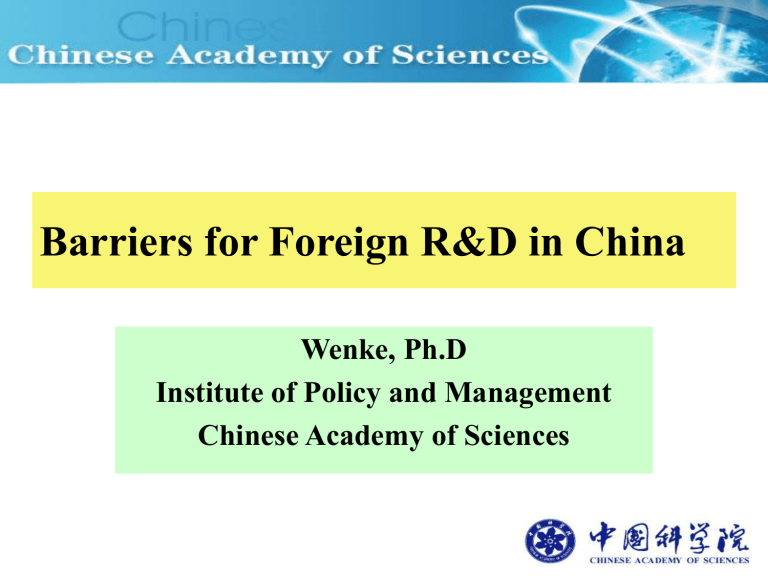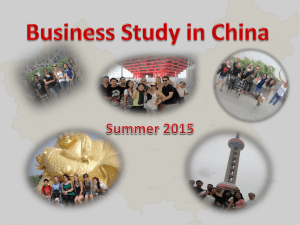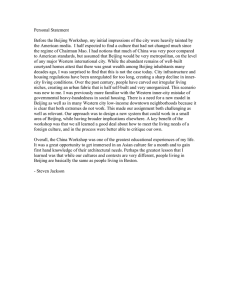Barriers for Foreign R D in China: Evidence from Foreign R D Investment in China
advertisement

Barriers for Foreign R&D in China Wenke, Ph.D Institute of Policy and Management Chinese Academy of Sciences Outline • • • • • Introduction Research methodology and data collection Three types of barriers for foreign R&D in China Several interesting patterns Conclusion 1.Introduction • Cooperating with Dr. Sun yifei, one part of the project “Foreign R&D Investment in China”(founded by NSF, BCS-0214042 ) • Focusing on the barriers for foreign R&D in china 2.Research methodology and data collection • The results are primarily based on 29 interviews with managers of foreign R&D in China. The empirical sample consisted of 27 multinational corporations. Establishment Year Location Industry Parent Country or Regions Location in global top500 Alcatel 2002 Shanghai Electronics France Bayer 2000 Shanghai Chemist Germany DaimlerChrysler 1999 Shanghai Automobile Germany Epson 1995 Shanghai Electronics Japan 385 129 7 435 Honeywell 2003 Shanghai Special Materials America Infeneon 2003 Shanghai Telecommunication Germany Jiaoda-Ormron 1989 Shanghai Software Japan a joint venture Sharp 2003 Shanghai Electronics Japan Unilever 1996 Shanghai Cosmetic British 249 70 AVL 2003 Shanghai Engine Austria AMD 2003 Beijing Electronics America Bell 1997 Beijing Communication America France TeleCom 2004 Beijing Telecommunication France Fujisu 1998 Beijing Electronics Japan IBM 1995 Beijing Software America Microsoft 1996 Beijing Software America Motorola 1998 Beijing Electronics America NEC 2003 Beijing Electronics Japan Nortel 1994 Beijing Communication Canada Nova Nordisk 2001 Beijing Pharmacy Denmark Sun 2001 Beijing Software America Toshiba 2001 Beijing Electronics Japan BenQ 2002 Nanjing Electronics Taiwan Lucent 2003 Nanjing Wireless America Phoenix Siemens Program and System Engineering 2003 Nanjing Electronics Germany 2004 Nanjing Telecommunication Austria CoreTek 2000 Chengdu Telecommunication America Parent Company 59 90 19 130 171 85 478 65 3. Three types of barriers • Barriers from policy environment – – – – Strong and bureaucratic government Import limitation Imperfect IPR protect system Difficulty for traveling to taiwan • Barriers from local market – Increasing operation cost – Imperfect infrastructure • Barriers with Human Resource Management – Lack of innovative and experienced labors – High employee mobility – Difficulty in managing the diversified staff 4.Several interesting patterns • Mainland-born managers and non Mainlandborn managers mainland-born managers are more positive about the environment in China. Mainland-born Non mainland-born managers (15) managers (13) Barriers from policy environment 8(44.4%) 13(46.4%) Strong and bureaucratic government 4 7 Import limitation 2 5 Imperfect IPR protect system 1 1 Difficulty for traveling to Taiwan 1 1 Barriers from local market 4(16.7%) 3(10.7%) High operation cost 3 1 Imperfect infrastructure 1 2 Barriers from human resource management 7(38.9%) 12(42.9%) High labor mobility 1 2 Lack of innovative talents 4 7 Difficulty in managing diversified staff 2 3 Total 19 29 4.Several interesting patterns • Variations among different cities R&D managers in difficult cities felt different problems, though common problems do exist Beijing (14) Shanghai (10) Nanjing (4) Barriers from policy environment 7(30.4%) 12(60%) 2(50%) Strong and bureaucratic government 4 5 2 Import limitation 3 4 0 Imperfect IPR protect system 1 1 0 Difficulty for traveling to Taiwan 0 2 0 Barriers from local market 2(8.7%) 4(20%) 1(25%) High operation cost 1 3 0 Imperfect infrastructure 1 1 1 Barriers from human resource management 14(60.9%) 4(20%) 1(25%) High labor mobility 0 3 0 Lack of innovative talents 9 1 1 Difficulty in managing diversified staff 5 0 0 Total 24 20 4 4.several interesting patterns • Differences among Companies with Different Presence in China The size of foreign investment is negative correlation to the barriers they encounter. We conducted case studies of company A and company B. A B Strong and bureaucratic government Yes No Import limitation Not mentioned No Imperfect IPR protect system Yes No High operation cost Not mentioned No Imperfect infrastructure Yes No High labor mobility Acceptable Acceptable Lack of innovative talents Yes Yes Difficulty in managing diversified staff No No Policy environment Local market Human resource management Total 5.Conclusions and discussion • Policy environment is still the major barrier, and other problems include high labor mobility, lack of talents and so on. • the feelings of R&D managers depend on the location of the establishment. • more established foreign companies seem to have experienced more problems than smaller and less prominent foreign companies.




